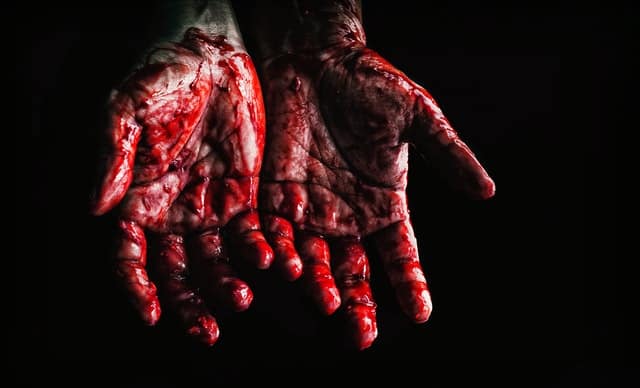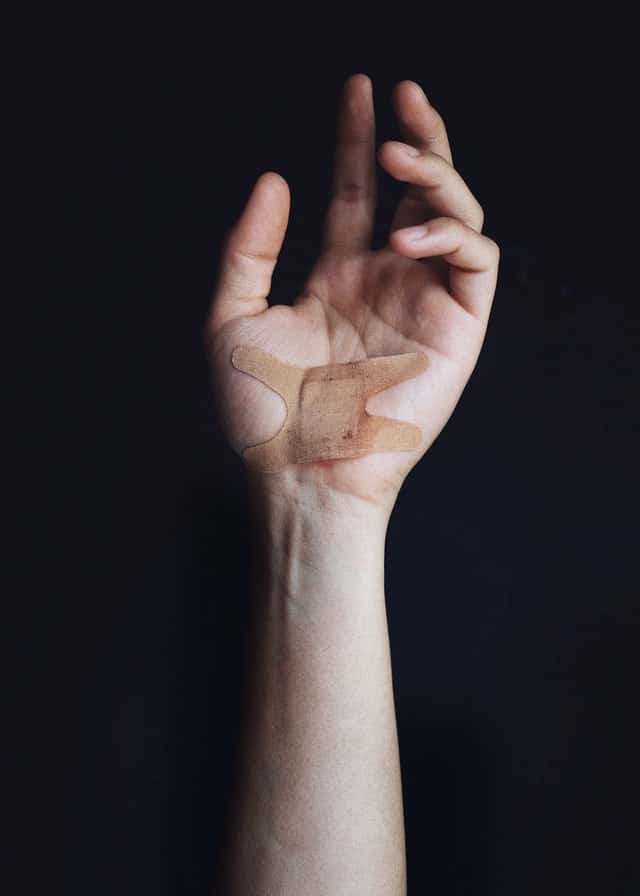WARNING: This article includes subject matter that may be disturbing to some readers.
How bad and unjust has your own small place in the world become when the only way you feel you can cope, to survive day-to-day, is to physically hurt yourself – to cut, to tear and to scar?Sadly, the practice of self-harm (also termed self-injury) is the dark reality for many teenagers growing up here in Washington state, and indeed across the American nation – for them, it is the only tangible coping mechanism, carried out in secret, away from the prying eyes of Mom and Dad and the others who love them, that seems to work on any level for these pained teens.
“That’s the way love sounds, my mother told me. You think it should feel like honey, but instead, it cuts like a knife.” – Alice Hoffman, New York novelist and author of “Incantation”
It is estimated that nearly 1 in 5 American children is today living with a mental health disorder, and that figure applies to Washington state too. Less than half of these will actually receive the treatment they need to get better, and to get on with simply being a child. Some are lucky and have been taught positive methods of coping with the wide variety of symptoms (many of which are invisible to others) caused by their disorder.
However, many children, teenagers, and adolescents are either undiagnosed, misunderstood or plain unsupported, and are left to deal with those same symptoms alone, often confused and scared, and where any way of coping with their feeling of mental turmoil is good enough, even if it means taking a sharp knife edge or a lit cigarette to their skin for just that one singular moment of feeling something different, something physical and tangible, just for the briefest moment of relief.
“The increase may be partly due to the impact that social media and technology has on the current generation. Kids might see their peers online engaging in self-harming behavior as a way to cope with their emotions, influencing them to replicate that type of behavior.” – Dr. Yolanda Evans, adolescent medicine specialist at Seattle Children’s, WA, on the recent increase in teenagers presenting with self-injuries caused by cutting, burning and scratching
An analysis of the Center for Disease Control’s (CDC) Youth Risk Behavior Surveillance System 2017 data shows that cases of self-harm (or nonsuicidal self-injury) have been rising during the last decade among teenagers from grades 9-12, as, too, have suicide-related behaviors.The main factors associated with this increase in self-harm include sadness, cyber-bullying, uncertainty, and confusion about their sexuality, being gay, lesbian or bisexual, perceived body image and weight issues, being forced to engage in sex, and substance abuse. As you can see, the need to simply protect our children and teenagers from the dangers of American modern living has, unfortunately, never been more crucial.With the announcement recently by Washington state’s schools chief Chris Reykdal that all schools would reopen and classes would resume in-person in the fall, there is obviously a lot of focus on the effect the coronavirus lockdown and enforced social isolation has had on the state’s children and teenagers. With most research proving the effect has been distinctly negative, there is a strong likelihood that rates of teen self-harm have risen during this time.
What is Self-Harm (Nonsuicidal Self-Injury)?
Self-harm, clinically termed nonsuicidal self-injury (NSSI), can be difficult to comprehend for both those teenagers who engage in the behavior, as well as their parents or caregivers. Looked upon by most as an unnatural practice, it is vital to understand why a particular teenager has resorted to such lengths, as their motivations to hurt themselves can vary so enormously. In fact, this primary motivation, whatever it may be, is the key to treatment, which should be centered upon addressing this motive.When a teenager engages in self-harm behavior, they do not have the intention to kill themselves – put bluntly, to die. In fact, many teenagers who self-injure do so as a way to cope with the stress of a particular situation, such as depression, being bullied through social media, or body image issues, or as a way to deal with the symptoms of a mental health disorder.For some teenagers (and for many self-harmers, whatever their age), the act of self-harm is seen as the opportunity to take control over what they are feeling. For others, it is a direct form of disassociation – a physical distraction from their emotional pain, eg. anxiety, loneliness, anger or a feeling emotional numbness.Furthermore, there is a body of neurobiological evidence that suggests that the act of self-harm activates certain brain chemicals, eg. endorphins, which temporarily relieve emotional turmoil.
Self-Harm: Prevalence & Statistics
Even though self-harm is not currently clinically regarded as a diagnosable mental health condition, there are around 2 million cases officially reported annually in the U.S. – that number is certainly far higher, as the sufferer can easily hide or explain away their injuries. Part of the “appeal” of the behavior is the level of secrecy associated with it.There are countless ways in which teenagers and adolescents engage in self-harm; however, by far the most common is cutting the skin with razor blades or pieces of glass. The most common forms of self-harm include:
- Skin cutting:70-90%
- Head banging/hitting:21-44%
- Flesh burning:15-35%
Other forms of self-harm can include:
- Poisoning / overdosing on non-harmful medications
- Inserting objects into one’s body
- Prevent wounds from healing properly
- Pulling out hair, eyelashes, or eyebrows
Much of this self-harm behavior in teenagers can be linked the teen’s attempt at the emotional regulation of the symptoms of mental health disorders, including borderline personality disorder (BPD), depression, and generalized anxiety disorder (GAD), and eating disorders, such as bulimia (bulimia nervosa).
Why Self-Harm? The Neurobiology of Nonsuicidal Self-Injury
It’s the question that every parent of a teenager, who secretively cuts, burns or scratches incessantly at the skin in an effort to draw either blood or pain, has asked themselves – Why does my teenager self-harm?At the 2019 Judy Dunn National Conference, held in London, England, on “Suicide & Self-Harm in Young People,” Christian Schmahl and his research team from the Central Institute of Mental Health in Mannheim, Germany, presented his findings on the subject.He stated that the majority of teenagers feel terrible when they experience physical pain and when they see any wound on their body. This pain intensifies any feelings of sadness, anger, and frustration that they feel. Most adults have a similar response too.However, teenagers who self-harm experience something quite different.Teens who self-harm are actually calmed by pain. Feelings of anger, sadness, and frustration disappear when the teen hurts themselves. They feel a distinct sense of relief during the act, and, afterward, they are happier and more content. Therefore, it would appear that the teenager who self-harms does so to regulate their emotions, and the reason as to why it works for them lies in their neurobiology – the chemical reaction that self-harm causes in their brain.Many teenagers will try out irregular techniques for managing their reactive emotions. Many try self-harm, but there is no beneficial neurobiological reaction, so they simply stop. However, self-harming teenagers experience the sight of blood and the sense of pain, but then experience a lowering of activity in the brain’s amygdala – the area of the brain that manages the rawest, most reactive feelings – as a direct result. So what does all this mean for the teenagers concerned, and their worried, even frantic parents?Teenagers who self-harm are not simply engaging in “sick, bad, attention-seeking” behavior, but do so because they have an abnormal neurobiological response to the act. Whereas when we experience pain or see blood, we respond in a way that worsens our feelings, the self-harming teen (or anyone who self-harms) feels a sense of calm.PLEASE INSERT THE FOLLOWING VIDEO: https://www.youtube.com/watch?v=3PFdhDKhEuc“Bullycide: Understanding Self-Harm,” presented by Jarryd Willis | TEDxUTA
The Link Between Self-Harm & Borderline Personality Disorder
Furthermore, Christian Schmahl and his German research team acknowledged a similar neurobiological response between teenagers who self-harm and adults with borderline personality disorder (BPD), a severe and hard-to-treat mental illness, which is further supported by research from Theodore Beauchaine, professor of psychology at Ohio State University.
“Self-injury is a phenomenon that’s increasing, and that’s less common outside of the U.S. It’s saying something about our culture that this is happening; we should do whatever we can to look for ways to prevent it.” – Theodore Beauchaine, psychology professor, Ohio State University
Professor Beauchaine led a study into the brains of teenage girls who engage in serious self-harm, which showed that their brain volume physically changes because of the self-harming behavior. In adults with BPD, structural and functional abnormalities are reported in areas of the brain that regulate emotions. Beauchaine’s study looked at the brains of adolescents who engage in self-harm to see if there were similar changes and found volume decreases in the insular cortex and inferior frontal gyrus of the brain.
Self-Harm: Signs & Symptoms
Identifying the signs and symptoms of self-harm is often difficult – thanks to the secrecy. However, parents and caregivers should be aware that physical and psychological signs and symptoms of self-harm can include:
- Consistent injuries: Consistent injuries, like cuts, burns, bruises to arms, legs or other parts of the body
- Cutting / Burning Implements: Finding your teen in possession of razors, pocket knives, and other sharp objects, cigarette lighters, matches, etc. that could cause harm
- Overdressing: In particularly during warm weather, those who self-harm may overdress, eg. wear coats, hats, scarves, or long sleeve shirts to hide recent marks on their body
- Repeatedly making excuses: Constant excuses on why or how they got injured
- Avoidance, isolation and social withdrawal: Normally from sports, activities, and relationships they have previously enjoyed
- Emotional warning signs: It is also important to remember emotional warning signs, such as difficulty handling emotions or relationships problems
- Other psychological signs:
- Changes in sleeping and eating patterns
- Hiding or washing their own clothes separately
- Avoiding situations which exposed their arms, eg, swimming, and a
- Sudden drop in performance at school or work
Self-Harm Treatment: Dialectical Behavioral Therapy (DBT)
Dialectical behavioral therapy (DBT) is traditionally used for people managing depression and anxiety, along with cognitive behavioral therapy (CBT). However, because DBT is associated with treating “externalizing behaviors,” such as self-injury, it has been shown as an excellent treatment for enabling self-harmers to learn how to be more aware of their emotions and behaviors. DBT specifically enables self- harming teenagers and others to:
- Manage emotions (emotion regulation)
- Cope with distress (distress tolerance)
- Form positive relationships (interpersonal effectiveness)
Northpoint Seattle: Imagine Mental Health Adolescent Day Treatment Program
Located in Bellevue, WA, and close to Seattle, Northpoint Seattle Bellevue offers an adolescent day treatment program called Imagine, specifically for 12-17-year-olds struggling with behavioral and mental health conditions, such as self-harm. Day treatment programming includes group participation, schooling, individual sessions, case management, psychiatric care, nursing care, and family therapy.Furthermore, all treatment is delivered by an interdisciplinary team of NCQA credentialed providers who use evidence-based treatment methods and criteria. The program offers the following therapies:
- CBT (Cognitive Behavioral Therapy)
- DBT (Didactic Behavioral Therapy)
- Grief and Loss, Trauma Therapy
- Crisis Intervention
- Co-Occurring Intervention
- Family Therapy
- Relationship Counseling
- Psychotherapy
- Interpersonal Therapy
- Mindfulness and Meditation
- Art, Music and Pet Therapy
“I was all about those cuts – like they were something about me that only I knew. They were like my own way of controlling things. I don’t cut myself anymore, but now I have to deal with the scars.” – Sandy, Washington state teenager (name changed)
IMPORTANT: If you are a Washington state resident and your child or family needs help right away, call the Washington Recovery Helpline at 866-789-1511. You can also call the National Suicide Prevention Lifeline, a national network of local crisis centers that provides free and confidential emotional support to people in suicidal crisis or emotional distress, at 1-800-273-8255, from anywhere in the U.S.








